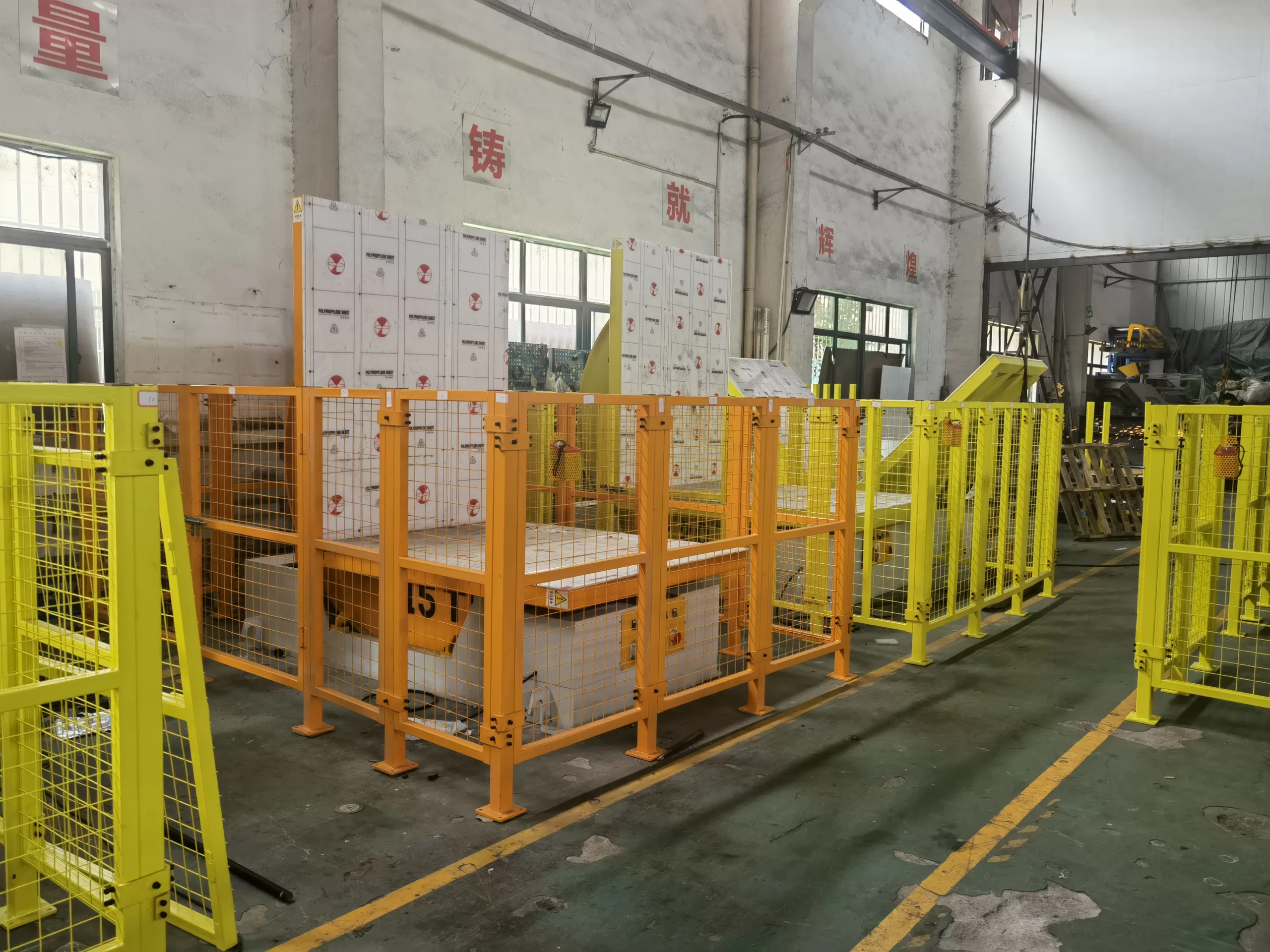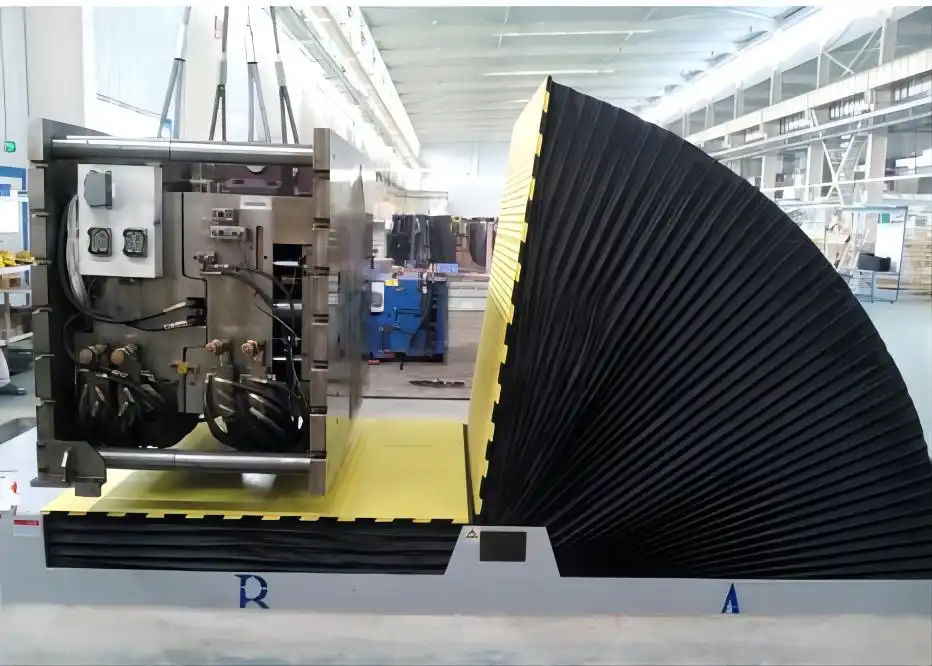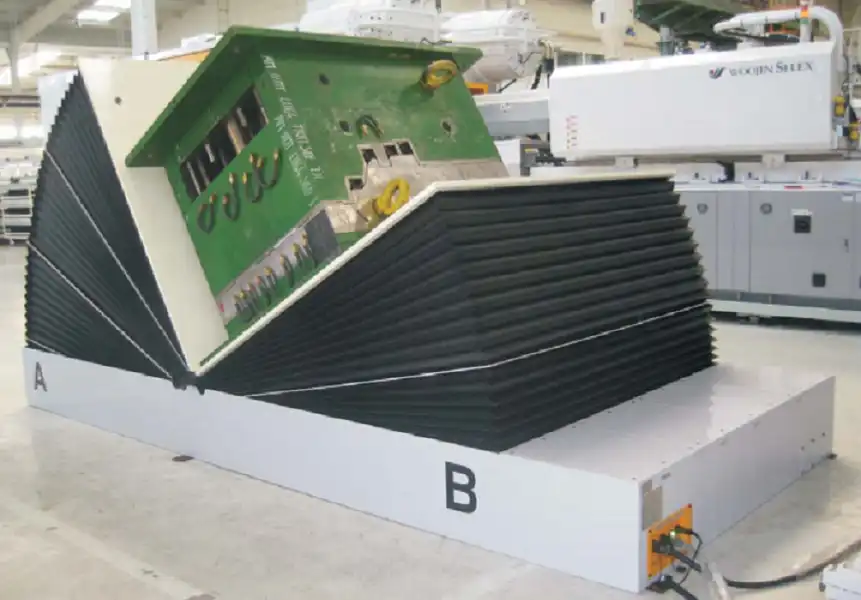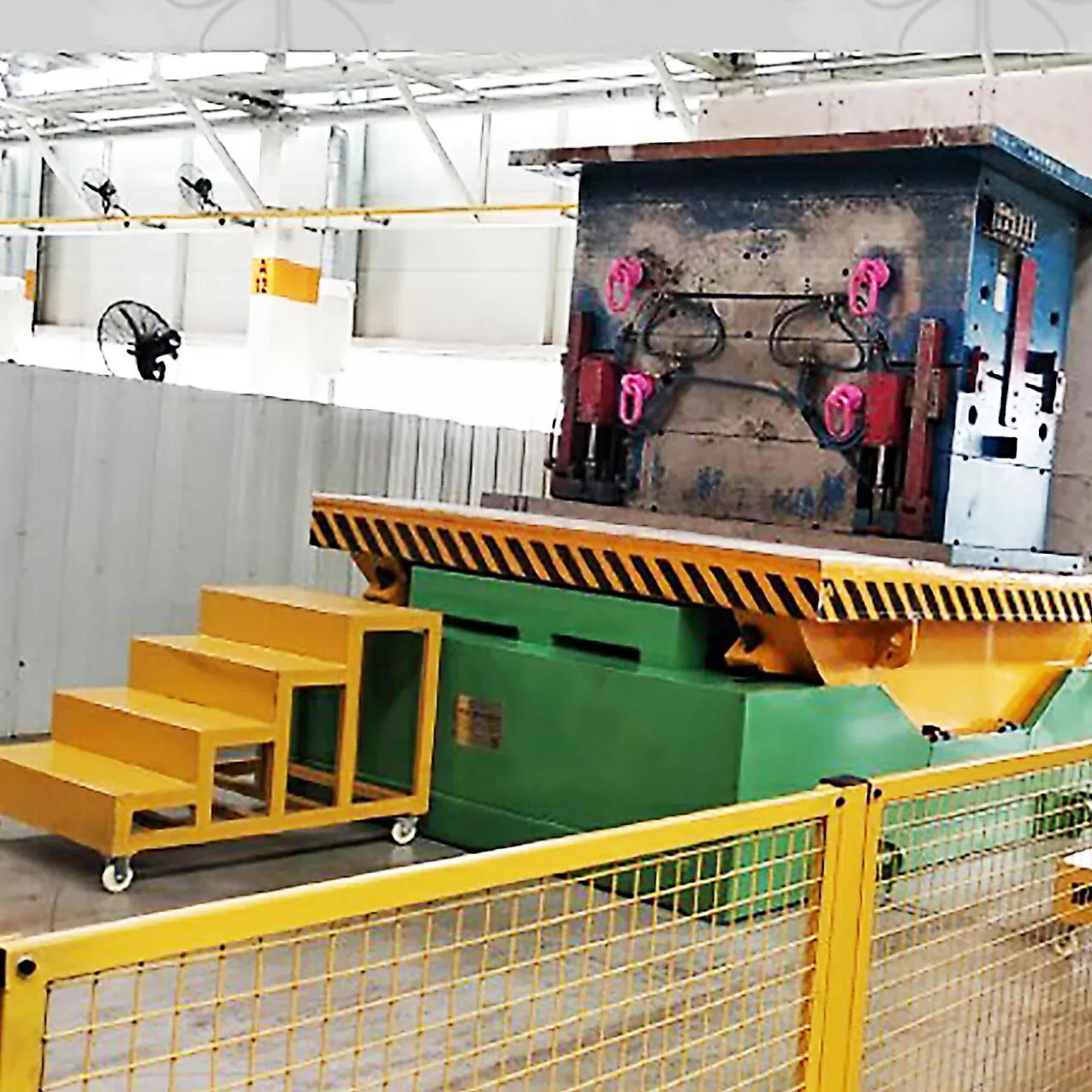Mold Flipper: Which Specs Matter Most for Thailand’s Automotive and Plastics Lines?
In Thailand's fast-paced automotive and plastics industries, every minute of production counts. But a hidden bottleneck is slowing down many factories: mold handling. A heavy, complex mold needs regular maintenance, and flipping it manually with a crane is slow, inefficient, and dangerous. A single slip can damage a million-baht mold, halt your production line for days, and put your team at serious risk. This constant, low-level inefficiency slowly erodes your profits and agility, making it harder to compete. A specialized mold flipper is the clear solution, but choosing the wrong one is just as bad as using a crane. It becomes an expensive, underused machine taking up valuable floor space. So, how do you select a machine that becomes a true asset for your specific needs in Thailand?
For Thailand's automotive and plastics lines, the most critical mold flipper specifications are capacity and table size to handle large, complex molds, robust safety features compliant with local regulations, and a drive system (hydraulic or electromechanical) that ensures smooth, precise rotation to protect sensitive mold components.

This gives you a starting point, but the real value is in the details. A spec sheet doesn't tell you how a machine will perform on a hot day in Chonburi or how it will integrate with your existing workflow. As an engineer who has built these machines and run a factory, I've learned that understanding the why behind each specification is what separates a good investment from a costly mistake. Let's break down the key questions you should be asking to ensure your choice delivers safety, efficiency, and a strong return on investment for years to come.
How does load capacity and table size directly impact your production efficiency?
You have a critical mold that needs urgent maintenance to get a priority order out the door. But the mold is slightly heavier than your flipper's rated capacity. You are forced to fall back on the old, slow method: calling over a crane and a team of workers. The process takes hours instead of minutes. Your new, expensive machine sits idle, and your production schedule slips. This isn't just a minor inconvenience; it's a direct hit to your efficiency and your ability to respond to customer demands. Choosing the wrong size is one of the most common and costly mistakes I see.
Load capacity and table size directly impact production efficiency by ensuring every mold, from the smallest to the largest, can be handled by the same automated process. This eliminates manual handling bottlenecks, reduces changeover times, and prevents production delays caused by an inability to service a specific mold quickly and safely.

Dive Deeper: Beyond the Maximum Weight
Choosing the right capacity isn't just about finding the weight of your heaviest mold and picking a number slightly above it. It's about a strategic analysis of your current and future needs. As a partner to my clients, not just a supplier, I always advise them to think five to ten years ahead.
Matching Capacity to Your Full Mold Inventory
You need to catalog your entire inventory of molds. Note the weight and dimensions of every single one. Don't just focus on the average or the most common. The outliers matter most. I remember a client in an automotive parts factory in Rayong. They bought a 10-ton flipper because 95% of their molds were under 8 tons. But their most profitable and complex product line used a mold that weighed 10.5 tons. For two years, that single mold created a constant bottleneck, requiring special manual handling that slowed down their most important production line.
When we worked with them, we didn't just look at their current list. We discussed their business plan. They were planning to bid on contracts for larger vehicle components. These new molds would be in the 12-15 ton range. By selecting a 15-ton machine, they not only solved their current bottleneck but also prepared their facility for future growth. The efficiency gains on their most profitable line alone paid for the machine in under 18 months. Always build in a buffer of at least 20-25% over your heaviest current mold. This accounts for future designs and prevents you from running the machine at its absolute limit, which increases wear and tear.
| Specification Choice | Impact on Operations | Financial Implication | Long-Term Risk |
|---|---|---|---|
| Undersized | Cannot handle all molds; creates bottlenecks. | Low initial cost, but high hidden costs from downtime. | Inability to take on new projects with larger molds. |
| Correctly Sized | Handles all current and projected molds efficiently. | Optimal investment; fast ROI through efficiency gains. | None, if future growth is accurately projected. |
| Oversized | Handles everything, but takes up excess space and energy. | Higher initial cost, wasted capital, higher energy use. | Inefficient use of factory floor space and capital budget. |
Why Table Dimensions Are More Than Just Numbers
The table size is just as critical. It's not just about length and width. You must consider the mold's center of gravity. An oddly shaped mold might fit within the dimensions but be unbalanced and unsafe to flip. The table design itself is crucial. Look for T-slots or other configurable clamping systems to securely hold various mold sizes. The table surface should also be considered. For high-precision molds used in plastics, a polyurethane or nylon-coated table surface prevents scratches and damage that could lead to flawed products. Also, think about logistics. How will you load the mold? The table design must have cutouts or a profile that works seamlessly with your existing forklifts or overhead cranes. A poorly designed table can add extra steps to every single mold handling operation, slowly bleeding away the efficiency you were trying to gain.
Which is better for Thailand’s climate: a hydraulic or electromechanical drive system?
The drive system is the heart of your mold flipper. You make a choice, and the machine is installed. Months later, on a typically hot and humid afternoon, a hydraulic line bursts. Hot, high-pressure fluid sprays across the floor, creating a major safety hazard and an environmental mess. Your maintenance team scrambles, but they don't have the specific fittings in stock. Your entire mold maintenance process grinds to a halt for two days while you wait for a part. This scenario highlights that the choice between hydraulic and electromechanical is not just technical—it's about reliability in your specific operating environment.
For Thailand’s hot and humid climate, an electromechanical drive system is often the better choice. It avoids the risk of hydraulic fluid leaks, requires less maintenance in high-temperature environments, and offers better energy efficiency and precision control, which are critical for both automotive and plastics applications.

Dive Deeper: Power, Precision, and Performance in the Heat
The debate between hydraulic and electromechanical systems is one I have with engineers and factory owners constantly. There's no single "best" answer for everyone, but for the specific conditions in most Thai factories, the evidence points in one direction.
The Strong Case for Electromechanical Systems
I've seen a clear shift towards electromechanical systems in modern factories, and for good reason. For the precision-driven automotive and plastics industries, control is everything. An electromechanical system, using a motor and gearbox, offers superior control over speed and positioning. The soft start and stop capabilities are incredibly smooth, preventing any jarring motions that could misalign sensitive mold components. This is crucial for complex molds with many moving parts.
Cleanliness is another major factor, especially in plastics manufacturing where any contamination can ruin a batch. Electromechanical systems are clean. There are no hydraulic fluids to leak, eliminating the risk of contaminating your production area or finished products.
Furthermore, let's talk about operating costs, a major concern for any forward-thinking owner. An electromechanical flipper consumes energy only when it's moving. A hydraulic system's pump often runs continuously to maintain pressure, consuming power even when the machine is idle. In a country with rising energy costs, these "idle" costs add up significantly over the machine's lifespan. The maintenance is also simpler. There are no hoses to replace, no fluid levels to check, and no filters to change, which is a big advantage in hot climates where hydraulic fluid can degrade faster.
When Hydraulic Power Still Has a Place
Despite the advantages of electromechanical drives, hydraulic systems are not obsolete. Their primary advantage is raw, brute-force power in a compact size. For factories dealing with extremely large and heavy molds—we're talking 50, 80, or even 100 tons—a hydraulic system can be a more cost-effective way to generate the immense torque required. The technology is mature and well-understood. For a factory with a skilled in-house maintenance team comfortable with hydraulics, repairs can sometimes be more straightforward than diagnosing an issue with a complex electronic drive or PLC.
| Feature | Hydraulic System | Electromechanical System | The Thai Context |
|---|---|---|---|
| Precision | Good, but can be prone to slight jolts. | Excellent, with smooth soft-start/stop. | Winner: Electro. Crucial for high-tolerance automotive and plastic molds. |
| Energy Efficiency | Lower; pump often runs continuously. | Higher; consumes power only during movement. | Winner: Electro. Aligns with goals to reduce operational energy costs. |
| Maintenance | Requires fluid, filter, and hose checks/changes. | Simpler; mainly gearbox lubrication. | Winner: Electro. Less complexity and fewer consumables are better in the heat. |
| Environmental Risk | Risk of fluid leaks and spills. | Minimal; no oil to leak. | Winner: Electro. Better for clean environments and easier compliance. |
| Performance in Heat | Fluid can thin and degrade; seals can fail. | Generally more stable, but electronics need proper cooling. | Winner: Electro. Fewer variables affected by ambient temperature and humidity. |
What safety features are non-negotiable for protecting your team and molds?
Imagine an operator is performing a routine mold flip. A sudden power outage hits the factory. Without the right safety mechanism, the multi-ton mold could slip from its position, crashing down. Or worse, a worker steps into the machine's rotation area to retrieve a dropped tool, not realizing the cycle has been initiated. These are not just risks; they are potential tragedies that can be completely avoided. Investing in equipment is one thing, but investing in the safety of your people is everything.
Non-negotiable safety features for a mold flipper include a robust mechanical locking system to prevent movement during power loss, perimeter fencing with light curtains or safety interlocks, emergency stop buttons accessible from all sides, and audible/visual alarms during operation. These features are essential for protecting both personnel and valuable molds.

Dive Deeper: A Layered Approach to Safety
Safety is not a single feature; it's a system of overlapping layers. When I started my career on the factory floor, I learned to respect heavy machinery. Now, as a designer and factory owner, I build that respect into every machine we produce. You can't cut corners on safety.
Active vs. Passive Safety Systems
It's helpful to think of safety in two categories. Passive safety is built into the machine's fundamental design. This includes things like a strong, over-engineered steel frame that can handle stresses far beyond its rated load, and mechanical locking systems. A mechanical brake or locking pin that automatically engages when power is cut is a prime example. It doesn't require any computer or sensor to work; it fails to a safe state through pure physics. This is your last line of defense, and it must be robust.
Active safety systems use sensors and logic to prevent an accident before it happens. This is where modern technology shines. Light curtains are a great example. They create an invisible field around the machine. If a person or object breaks that field while the machine is in motion, the system instantly stops. It's a proactive measure that prevents a person from ever being in a dangerous position. These systems are critical in busy factory environments where multiple tasks are happening at once.
Breakdown of Essential Safety Components
When you review a quote for a mold flipper, look for these specific items. If they are listed as optional, question it. For my company, SHJLPACK, they are standard.
- Mechanical Anti-Fall Brakes: This is non-negotiable. Ask the manufacturer to explain exactly how their system works in a power failure.
- Perimeter Guarding with Interlocked Gates: A physical fence is the clearest way to define the danger zone. The gates must have interlock switches, meaning the machine cannot start if a gate is open, and it will stop immediately if a gate is opened during operation.
- Light Curtains: For high-traffic areas where a full fence isn't practical, light curtains provide an effective and flexible safety barrier.
- Accessible E-Stops: There must be multiple, clearly marked Emergency Stop buttons located around the machine so that anyone can halt it instantly from any position.
- Audible and Visual Alarms: A flashing light and a loud beeper should activate just before and during any movement, alerting everyone in the vicinity that the machine is in operation.
- Overload Protection: The drive system must have sensors that prevent it from attempting to flip a mold that exceeds its rated capacity.
| Safety Feature | Risk if Absent | How it Protects Staff | How it Protects Molds |
|---|---|---|---|
| Mechanical Brake | Mold drops during power failure. | Prevents catastrophic crushing injuries. | Prevents total destruction of the mold from a fall. |
| Light Curtain | A person enters the operating area undetected. | Stops the machine before impact can occur. | Prevents collision with foreign objects (e.g., forklifts). |
| Interlocked Gate | Unauthorized access to the danger zone. | Ensures no one can be inside the area during a cycle. | Protects the machine from being hit by passing traffic. |
| Overload Sensor | Attempting to lift a mold that is too heavy. | Prevents catastrophic failure of the drive/frame. | Prevents over-stressing and damaging the mold's structure. |
I once had a potential customer who wanted to reduce the price by removing the light curtain system. I refused the sale. I explained that the potential cost of one serious accident—in hospital bills, government fines, and lost production—was more than ten times the cost of the safety system. He later called back and approved the original design. Protecting your team isn't an expense; it's the most important investment you will ever make.
How can integration and smart features boost your ROI?
You've invested in a state-of-the-art mold flipper. It's safe and efficient. But it operates as an island. Your maintenance planner has to manually walk over to check a machine's hour meter to schedule service. If it has a problem, you have to wait for an expensive technician to travel to your site to diagnose it. The machine does its job, but it doesn't communicate. It doesn't provide data. In the modern factory, a machine that doesn't talk is a machine that isn't pulling its full weight.
Integration and smart features boost ROI by reducing manual data entry, enabling predictive maintenance, and streamlining workflows. Features like PLC integration with your MES system, remote diagnostics, and cycle tracking provide valuable data that helps optimize maintenance schedules, minimize downtime, and increase overall equipment effectiveness (OEE).

Dive Deeper: From a Dumb Tool to a Smart Asset
This is the area that excites me the most as an engineer. It’s how we transform a piece of heavy equipment into a strategic part of a digital factory. This is what separates a basic supplier from a true technology partner. It's about looking at the machine not just for what it does, but for the information it can provide.
The Power of PLC and MES Integration
Many modern factories in Thailand's automotive and plastics sectors run on a Manufacturing Execution System (MES). This is the digital brain of the operation. A "smart" mold flipper should be able to connect directly to it. Its PLC (Programmable Logic Controller) can send and receive information. Imagine the workflow: a mold arrives at the maintenance bay. A barcode is scanned. The MES already knows this is mold #734, it weighs 8.2 tons, and it requires maintenance procedure B. It sends this information to the mold flipper, which confirms the weight is within its capacity and pre-loads the correct operating parameters. The operator simply confirms the action on a screen. Once the flip is complete, the flipper sends a "task complete" signal back to the MES, which then updates the mold's maintenance record and location automatically. This eliminates manual data entry, reduces the chance of human error, and creates a seamless, transparent digital thread.
Key Smart Features That Drive ROI
When looking at a mold flipper, ask about these capabilities. They are the features that provide a return on investment that goes far beyond simply turning a mold over.
- Remote Diagnostics: This is a huge cost-saver. If the machine has an error, it can connect to the internet and allow our technicians at SHJLPACK to log in, see the error codes, and analyze the sensor data. In many cases, we can diagnose the problem and guide your on-site team through the fix over the phone, saving you the time and expense of a service visit.
- Predictive Maintenance Alerts: Instead of servicing a machine every six months, a smart machine tells you when it needs service. It tracks its own operating hours and cycle counts. It can send an email or an MES alert saying, "My gearbox has run for 1,950 hours. Schedule an oil change within the next 50 hours." This is the foundation of predictive maintenance, which is key to achieving a high OEE.
- Energy Consumption Monitoring: A smart flipper can track exactly how much electricity it uses per cycle or per hour. This data is invaluable for managers who are tasked with reducing the factory's overall energy consumption. You can't improve what you can't measure.
| Feature | Standard Flipper (How it works) | Smart Flipper (How it works) | Impact on ROI |
|---|---|---|---|
| Maintenance | Fixed schedule (e.g., every 6 months), reactive repairs. | Condition-based alerts, predictive scheduling. | Reduces downtime, lowers maintenance costs, extends machine life. |
| Troubleshooting | Wait for a technician to travel to the site. | Remote diagnostics via internet connection. | Drastically reduces downtime and service costs. |
| Performance Tracking | Manual logs or non-existent. | Automatic cycle counting and OEE data sent to MES. | Provides actionable data for continuous process improvement. |
| Operator Interaction | Manual button pressing for every step. | Scans a work order, receives instructions from MES, one-touch operation. | Reduces operator error, speeds up the process, improves workflow efficiency. |
This is the future. Building strong machines is no longer enough. We must build smart machines that become active partners in achieving our clients' goals for efficiency, cost reduction, and digitalization.
Conclusion
Choosing the right mold flipper means matching specs to your factory's reality. Focus on capacity, the correct drive system, non-negotiable safety, and smart integration for the best long-term value.




